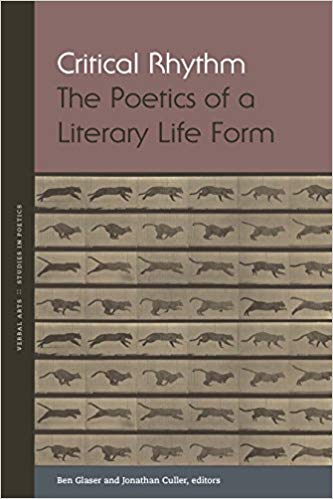B. Glaser & J. Culler (ed.), Critical Rhythm : The Poetics of a Literary Life Form, New York, Fordham University Press, 288 p.
- “What does it mean, and what has it meant historically, to participate in verse’s rhythmic patternings ? This volume, with incandescent and defamiliarizing rhythms of its own, takes up rhythm as the central, ever-fugitive term in debates over sound and sense, the visible and the audible, the history of prosodic discourses, and methodological approaches to reading and performance. Reaching beyond the metrical constraints of foot prosody to powers of rhythm generally left underexplored in Anglo-American criticism, the formidable array of scholars gathered here opens up resonant inquiries into empirical, historical, ontological, phenomenological, and allegorical dimensions of rhythm in English-language verse of the past two centuries.”―Max Cavitch, University of Pennsylvania
Rhythm constitutes an untapped resource for understanding poetry. Amid debates over formalism, historicism, and poetics, this book reveals rhythm as a defamiliarizing aesthetic force yet an unstable concept. Distinct from the related terms to which it’s often assimilated―scansion, prosody, meter―rhythm makes legible a range of ways poetry affects us that cannot be parsed through the traditional resources of poetic theory.
Rhythm has rich but also problematic roots in nineteenth-century notions of primitive, oral, communal, and sometimes racialized poetics. But there are reasons to understand and even embrace its seductions, including its resistance to lyrical voice and even identity. Warning against taking rhythm to refer to a given form, the essays press beyond poetry handbooks’ isolated descriptions of technique in order to ask what it means to think rhythm.
Rhythm, the contributors show, happens relative to the body and also to language―two categories that are distinct from the literary, the mode through which poetics is usually analyzed. Beyond articulating what rhythm does to poetry, the contributors undertake a genealogical and theoretical analysis of how rhythm as a human experience has come to be articulated through poetry and poetics. The resulting work helps us better understand poetry both on its own terms and in its continuities with other experiences and other arts.
- Contributors : Derek Attridge, Tom Cable, Jonathan Culler, Natalie Gerber, Ben Glaser, Virginia Jackson, Simon Jarvis, Ewan Jones, Erin Kappeler, Meredith Martin, David Nowell Smith, Yopie Prins, Haun Saussy
- Ben Glaser is Assistant Professor of English at Yale University. Jonathan Culler is Class of 1916 Professor of English and Comparative Literature at Cornell University.

